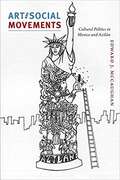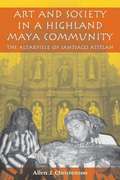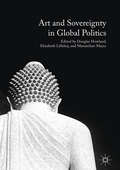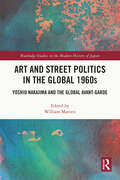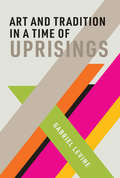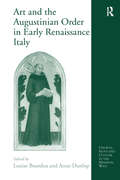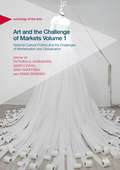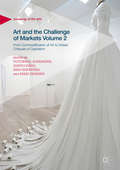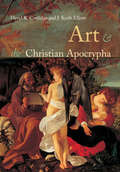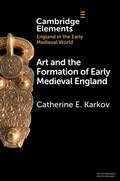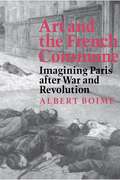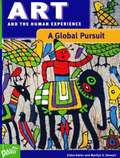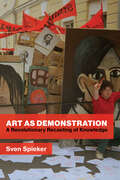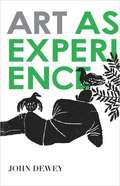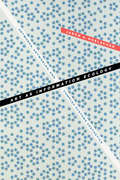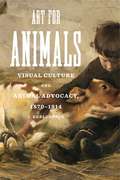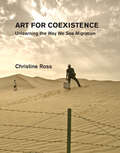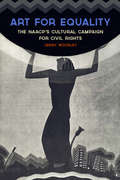- Table View
- List View
Art and Social Movements: Cultural Politics in Mexico and Aztlán
by Edward J. McCaughanArt and Social Movements offers a comparative, cross-border analysis of the role of visual artists in three social movements from the late 1960s through the early 1990s: the 1968 student movement and related activist art collectives in Mexico City, a Zapotec indigenous struggle in Oaxaca, and the Chicano movement in California. Based on extensive archival research and interviews, Edward J. McCaughan explores how artists helped to shape the identities and visions of a generation of Mexican and Chicano activists by creating new visual discourses. <p><p> McCaughan argues that the social power of activist artists emanates from their ability to provoke people to see, think, and act in innovative ways. Artists, he claims, help to create visual languages and spaces through which activists can imagine and perform new collective identities and forms of meaningful citizenship. The artists' work that he discusses remains vital today—in movements demanding fuller democratic rights and social justice for working people, women, ethnic communities, immigrants, and sexual minorities throughout Mexico and the United States. Integrating insights from scholarship on the cultural politics of representation with structural analyses of specific historical contexts, McCaughan expands our understanding of social movements.
Art and Society in a Highland Maya Community
by Allen J. Christenson"Allen J. Christenson offers us in this wonderful book a testimony to contemporary Maya artistic creativity in the shadow of civil war, natural disaster, and rampant modernization. Trained in art history and thoroughly acquainted with the historical and modern ethnography of the Maya area, Christenson chronicles in this beautifully illustrated work the reconstruction of the central altarpiece of the Maya Church of Tz'utujil-speaking Santiago Atitlán, Guatemala. The much-loved colonial-era shrine collapsed after a series of destructive earthquakes in the twentieth century. Christenson's close friendship with the Chávez brothers, the native Maya artists who reconstructed the shrine in close consultation with village elders, enables him to provide detailed exegesis of how this complex work of art translates into material form the theology and cosmology of the traditional Tz'utujil Maya. With the author's guidance, we are taught to see this remarkable work of art as the Maya Christian cosmogram that it is. Although it has the triptych form of a conventional Catholic altarpiece, its iconography reveals a profoundly Maya narrative, replete with sacred mountains and life-giving caves, with the whole articulated by a central axis mundi motif in the form of a sacred tree or maize plant (ambiguity intended) that is reminiscent of well-known ancient Maya ideas. Through Christenson's focused analysis of the iconography of this shrine, we are able to see and understand almost firsthand how the modern Maya people of Santiago Atitlán have remembered the imagined universe of their ancestors and placed upon this sacred framework their received truths in time present. "--Gary H. Gossen, Distinguished Professor Emeritus of Anthropology and Latin American Studies, University at Albany, SUNY
Art and Sovereignty in Global Politics
by Maximilian Mayer Douglas Howland Elizabeth LillehojThis volume aims to question, challenge, supplement, and revise current understandings of the relationship between aesthetic and political operations. The authors transcend disciplinary boundaries and nurture a wide-ranging sensibility about art and sovereignty, two highly complex and interwoven dimensions of human experience that have rarely been explored by scholars in one conceptual space. Several chapters consider the intertwining of modern philosophical currents and modernist artistic forms, in particular those revealing formal abstraction, stylistic experimentation, self-conscious expression, and resistance to traditional definitions of "Art. " Other chapters deal with currents that emerged as facets of art became increasingly commercialized, merging with industrial design and popular entertainment industries. Some contributors address Post-Modernist art and theory, highlighting power relations and providing sceptical, critical commentary on repercussions of colonialism and notions of universal truths rooted in Western ideals. By interfering with established dichotomies and unsettling stable debates related to art and sovereignty, all contributors frame new perspectives on the co-constitution of artworks and practices of sovereignty.
Art and Street Politics in the Global 1960s: Yoshio Nakajima and the Global Avant-Garde (Routledge Studies in the Modern History of Japan)
by William MarottiAnarchic street performances in late-1950s Japan; inauguration of the first Happenings in Antwerp and charging of the "magic circle" in Amsterdam; Bauhaus Situationiste and anti-national art exchanges, networks and communes. As "Happener" and "Art Missionary," Yoshio Nakajima’s storied career traverses an astounding range of locations, scenes, movements, media, and performance modes in the global 1960s and 1970s in ways that challenge our notions of the possibilities of art. Nakajima repeatedly plays a role in jump-starting spaces of possibility, from Tokyo to Ubbeboda, from Spui Square and the Dutch Provos to Antwerp and Sweden. Despite this, Nakajima’s work has paradoxically been largely excluded from accounts where it might have justifiably featured. The present volume represents an international collaboration of researchers working to remedy this oversight. Nakajima’s work demands a reconceptualization of narratives of this art and politics and their specific interrelation to consider his exemplary nonconformity—and its exemplary exclusion. This history demonstrates the inadequacy of notions of specificity that would oppose an authentic local or national frame to an inauthentic transnational one. Conversely, Nakajima manifests a key dimension of the 1960s as a global event in the interrelation between eventfulness itself and the redrawing of categories of practice and understanding.
Art and Tradition in a Time of Uprisings
by Gabriel LevineExamining radical reinventions of traditional practices, ranging from a queer reclamation of the Jewish festival of Purim to an Indigenous remixing of musical traditions.Supposedly outmoded modes of doing and making—from music and religious rituals to crafting and cooking—are flourishing, both artistically and politically, in the digital age. In this book, Gabriel Levine examines collective projects that reclaim and reinvent tradition in contemporary North America, both within and beyond the frames of art. Levine argues that, in a time of political reaction and mass uprisings, the subversion of the traditional is galvanizing artists, activists, musicians, and people in everyday life. He shows that this takes place in strikingly different ways for Indigenous and non-Indigenous people in settler colonies. Paradoxically, experimenting with practices that have been abandoned or suppressed can offer powerful resources for creation and struggle in the present.Levine shows that, in projects that span “the discontinuum of tradition,” strange encounters take place across the lines of class, Indigeneity, race, and generations. These encounters spark alliance and appropriation, desire and misunderstanding, creative (mis)translation and radical revisionism. He describes the yearly Purim Extravaganza, which gathers queer, leftist, and Yiddishist New Yorkers in a profane reappropriation of the springtime Jewish festival; the Ottawa-based Indigenous DJ collective A Tribe Called Red, who combine traditional powwow drumming and singing with electronic dance music; and the revival of home fermentation practices—considering it from microbiological, philosophical, aesthetic, and political angles.Projects that take back the vernacular in this way, Levine argues, not only develop innovative forms of practice for a time of uprisings; they can also work toward collectively reclaiming, remaking, and repairing a damaged world.
Art and Vision in the Inca Empire
by Adam HerringIn 1500 CE, the Inca empire covered most of South America's Andean region. The empire's leaders first met Europeans on November 15, 1532, when a large Inca army confronted Francisco Pizarro's band of adventurers in the highland Andean valley of Cajamarca, Peru. At few other times in its history would the Inca royal leadership so aggressively showcase its moral authority and political power. Glittering and truculent, what Europeans witnessed at Inca Cajamarca compels revised understandings of pre-contact Inca visual art, spatial practice, and bodily expression. This book takes a fresh look at the encounter at Cajamarca, using the episode to offer a new, art-historical interpretation of pre-contact Inca culture and power. Adam Herring's study offers close readings of Inca and Andean art in a variety of media: architecture and landscape, geoglyphs, sculpture, textiles, ceramics, featherwork and metalwork. The volume is richly illustrated with over sixty color images.
Art and the Augustinian Order in Early Renaissance Italy (Church, Faith and Culture in the Medieval West)
by Anne DunlopThe rise of the mendicant orders in the later Middle Ages coincided with rapid and dramatic shifts in the visual arts. The mendicants were prolific patrons, relying on artworks to instruct and impress their diverse lay congregations. Churches and chapels were built, and new images and iconographies developed to propagate mendicant cults. But how should the two phenomena be related? How much were these orders actively responsible for artistic change, and how much did they simply benefit from it? To explore these questions, Art and the Augustinian Order in Early Renaissance Italy looks at art in the formative period of the Augustinian Hermits, an order with a particularly difficult relation to art. As a first detailed study of visual culture in the Augustinian order, this book will be a basic resource, making available previously inaccessible material, discussing both well-known and more neglected artworks, and engaging with fundamental methodological questions for pre-modern art and church history, from the creation of religious iconographies to the role of gender in art.
Art and the Challenge of Markets Volume 1: National Cultural Politics and the Challenges of Marketization and Globalization (Sociology of the Arts)
by Victoria D. Alexander Samuli Hägg Simo Häyrynen Erkki SevänenArt and the Challenge of Markets Volumes 1 & 2 examine the politics of art and culture in light of the profound changes that have taken place in the world order since the 1980s and 1990s. The contributors explore how in these two decades, the neoliberal or market-based model of capitalism started to spread from the economic realm to other areas of society. As a result, many aspects of contemporary Western societies increasingly function in the same way as the private enterprise sector under traditional market capitalism. The first volume of this two-volume collection considers a broad range of national cultural policies from European and North American countries, and examines the strengthening of international and transnational art worlds in music, visual arts, film, and television. The chapters cover cultural policy and political culture in the United States, United Kingdom, Germany, France, Switzerland, the Nordic countries, the Balkans, and Slovenia, and address the extent to which Western nations have shifted from welfare-state to market-based ideologies. Tensions between centres and peripheries in global art worlds are considered, as well as complex interactions between nations and international and transnational art worlds, and regional variations in the audiovisual market. Both volumes provide students and scholars across a range of disciplines with an incisive, comparative overview of the politics of art and culture and national, international and transnational art worlds in contemporary capitalism.
Art and the Challenge of Markets Volume 2: From Commodification of Art to Artistic Critiques of Capitalism (Sociology of the Arts)
by Victoria D. Alexander Samuli Hägg Simo Häyrynen Erkki SevänenArt and the Challenge of Markets Volumes 1 & 2 examine the politics of art and culture in light of the profound changes that have taken place in the world order since the 1980s and 1990s. The contributors explore how in these two decades, the neoliberal or market-based model of capitalism started to spread from the economic realm to other areas of society. As a result, many aspects of contemporary Western societies increasingly function in the same way as the private enterprise sector under traditional market capitalism. This second volume analyses the relationships of art with contemporary capitalist economies and instrumentalist cultural policies, and examines several varieties of capitalist-critical and alternative art forms that exist in today's art worlds. It also addresses the vexed issues of art controversies and censorship. The chapters cover issues such as the culturalization of the economy, aesthetics and anti-aesthetics, the societal benefits of works of art, art's responsibility to society, "artivism", activist arts as protest and capitalism-critical works, and controversies over nudity in art, as well as considering the marketisation of emerging visual arts worlds in East Asia. The book ends with the a concluding chapter suggesting that even in today's marketized and commercialized environments, art will find a way. Both volumes provide students and scholars across a range of disciplines with an incisive, comparative overview of the politics of art and culture and national, international and transnational art worlds in contemporary capitalism.
Art and the Christian Apocrypha
by David R. Cartlidge J. Keith ElliotThe Christian canon of scripture, known as the New Testament, excluded many of the Church's traditional stories about its origins. Although not in the Bible, these popular stories have had a powerful influence on the Church's traditions and theology, and a particularly marked effect on visual representations of Christian belief. This book provides a lucid introduction to the relationship between the apocryphal texts and the paintings, mosaics, and sculpture in which they are frequently paralleled, and which have been so significant in transmitting these non-Biblical stories to generations of churchgoers.
Art and the Formation of Early Medieval England (Elements in England in the Early Medieval World)
by Catherine E. KarkovThis Element covers the art produced in early medieval England from the departure of the Romans to the early twelfth century, an art that shows the input of multi-ethnic artists, patrons, and influences as it develops over the centuries. Art in early medieval England is an art of migrants and colonisers and the Element considers the way in which it was defined and developed by the different groups that travelled to or settled on the island. It also explores some of the key forms and images that define the art of the period and the role of both material and artist/patron in their creation. Art is an expression of identity, whether individual, regional, national, religious, or institutional, and this volume sheds light on the way art in early medieval England was and continues to be used to define particular identities, including that of the island on which it was produced.
Art and the French Commune: Imagining Paris after War and Revolution (Princeton Series in 19th Century Art, Culture, and Society #2)
by Albert BoimeIn this bold exploration of the political forces that shaped Impressionism, Albert Boime proposes that at the heart of the modern is a "guilty secret"--the need of the dominant, mainly bourgeois, classes in Paris to expunge from historical memory the haunting nightmare of the Commune and its socialist ideology. The Commune of 1871 emerged after the Prussian war when the Paris militia chased the central government to Versailles, enabling the working class and its allies to seize control of the capital. Eventually violence engulfed the city as traditional liberals and moderates joined forces with reactionaries to restore Paris to "order"--the bourgeois order. Here Boime examines the rise of Impressionism in relation to the efforts of the reinstated conservative government to "rebuild" Paris, to return it to its Haussmannian appearance and erase all reminders of socialist threat. Boime contends that an organized Impressionist movement owed its initiating impulse to its complicity with the state's program. The exuberant street scenes, spaces of leisure and entertainment, sunlit parks and gardens, the entire concourse of movement as filtered through an atmosphere of scintillating light and color all constitute an effort to reclaim Paris visually and symbolically for the bourgeoisie. Amply documented, richly illustrated, and compellingly argued, Boime's thesis serves as a challenge to all cultural historians interested in the rise of modernism.
Art and the Global Economy
by John ZarobellArt and the Global Economy analyzes major changes in the global art world that have emerged in the last twenty years including structural shifts in the global art market; the proliferation of international art fairs, biennials and blockbuster exhibitions; and the internationalization of the scope of contemporary art. John Zarobell explores the economic and social transformations in the cultural sphere, the results of greater access to information about art, exhibitions, and markets around the world, as well as the increasing interpenetration of formerly distinct geographical domains. By considering a variety of locations—both long-standing art capitals and up-and-coming centers of the future—Art and the Global Economy facilitates a deeper understanding of how globalization affects the domain of the visual arts in the twenty-first century. With contributions by Lucia Cantero, Mariana David, Valentin Diaconov, Kai Lossgott, Grace Murray, Chhoti Rao, Emma Rogers and Michelle Wong.
Art and the Human Experience: A Global Pursuit
by Eldon Katter Marilyn G. StewartLEVEL: Middle School. Teach the BIG IDEAS using the basic foundations of art. Elements and Principles -- Focus on mastering art's building blocks: Line and pattern; Light, value, and contrast; Proportion and scale, and more. Art History -- Focus on the Western world: Covers the ancient world to the present; Connects to each chapter's themes; Timeline and historical context in every chapter. Multicultural -- Focus on world cultural contributions to art: Native North America; China and Korea and more; Maps in every chapter.
Art and the Performance of Memory: Sounds and Gestures of Recollection (Routledge Studies in Memory and Narrative)
by Richard Cándida SmithThis book investigates the role that the visual and performing arts play in our experience and understanding of the past. Expanding upon longstanding concerns in cultural history about the relation of text and image, the book highlights the distinction between enactive and cognitive memory and the implications of this for artists and their publics.
Art and the Religious Image in El Greco’s Italy
by Andrew R. CasperArt and the Religious Image in El Greco’s Italy is the first book-length examination of the early career of one of the early modern period’s most notoriously misunderstood figures. Born around 1541, Domenikos Theotokopoulos began his career as an icon painter on the island of Crete. He is best known, under the name “El Greco,” for the works he created while in Spain, paintings that have provoked both rapt admiration and scornful disapproval since his death in 1614. But the nearly ten years he spent in Venice and Rome, from 1567 to 1576, have remained underexplored until now. Andrew Casper’s examination of this period allows us to gain a proper understanding of El Greco’s entire career and reveals much about the tumultuous environment for religious painting after the Council of Trent.Art and the Religious Image in El Greco’s Italy is a new book in the Art History Publication Initiative (AHPI), a collaborative grant from the Andrew W. Mellon Foundation. Thanks to the AHPI grant, this book will be available in popular e-book formats.
Art and the Religious Image in El Greco’s Italy
by Andrew R. CasperArt and the Religious Image in El Greco’s Italy is the first book-length examination of the early career of one of the early modern period’s most notoriously misunderstood figures. Born around 1541, Domenikos Theotokopoulos began his career as an icon painter on the island of Crete. He is best known, under the name “El Greco,” for the works he created while in Spain, paintings that have provoked both rapt admiration and scornful disapproval since his death in 1614. But the nearly ten years he spent in Venice and Rome, from 1567 to 1576, have remained underexplored until now. Andrew Casper’s examination of this period allows us to gain a proper understanding of El Greco’s entire career and reveals much about the tumultuous environment for religious painting after the Council of Trent.Art and the Religious Image in El Greco’s Italy is a new book in the Art History Publication Initiative (AHPI), a collaborative grant from the Andrew W. Mellon Foundation. Thanks to the AHPI grant, this book will be available in popular e-book formats.
Art as Culture: An Introduction to the Anthropology of Art
by Evelyn Payne Hatcheran introduction of art as it relates to anthropology
Art as Demonstration: A Revolutionary Recasting of Knowledge
by Sven SpiekerHow artists wield demonstration to question the status quo both aesthetically and politically, marshaling art and education as powerful agents of change.Demonstration, in short, says: See here. It is the practice of pointing to something in order to explain or contest it. As such, Sven Spieker argues that demonstration has helped reshape art from the height of the Cold War to the late twentieth century, reformatting our understanding of how art and political engagement relate to each other. Focusing on Western Europe (especially Germany), Eastern Europe, and the United States, Art as Demonstration expands on contemporary discussions of art-as-protest, activism, and resistance. Spieker shows how a closer, more historical look at art&’s connection with demonstration reconnects us with earlier efforts, notably by the early twentieth-century avant-garde, to marshal art for the purpose of instruction and engagement.Art as Demonstration reconceives the history of postwar art in Eastern and Western Europe from the perspective of demonstration, understood formally (as a technique for showing and pointing) as well as politically (as protest, resistance, etc.). Close analyses of individual artworks reveal how the deployment of demonstration has changed over time. Spieker shows how &“protest&” and &“resistance&” organize art and artists not only politically but also and especially formally and aesthetically—a development of particular importance in the Cold War art and politics of Eastern Europe. The book illustrates how from the 1960s onward demonstration radically changed the way artists thought about art: no longer as an object but as a form of education.
Art as Experience
by John DeweyBased on John Dewey's lectures on esthetics, delivered as the first William James Lecturer at Harvard in 1932, Art as Experience has grown to be considered internationally as the most distinguished work ever written by an American on the formal structure and characteristic effects of all the arts: architecture, sculpture, painting, music, and literature.
Art as Information Ecology: Artworks, Artworlds, and Complex Systems Aesthetics (Thought in the Act)
by Jason A. HoelscherIn Art as Information Ecology, Jason A. Hoelscher offers not only an information theory of art but an aesthetic theory of information. Applying close readings of the information theories of Claude Shannon and Gilbert Simondon to 1960s American art, Hoelscher proposes that art is information in its aesthetic or indeterminate mode—information oriented less toward answers and resolvability than toward questions, irresolvability, and sustained difference. These irresolvable differences, Hoelscher demonstrates, fuel the richness of aesthetic experience by which viewers glean new information and insight from each encounter with an artwork. In this way, art constitutes information that remains in formation---a difference that makes a difference that keeps on differencing. Considering the works of Frank Stella, Robert Morris, Adrian Piper, the Drop City commune, Eva Hesse, and others, Hoelscher finds that art exists within an information ecology of complex feedback between artwork and artworld that is driven by the unfolding of difference. By charting how information in its aesthetic mode can exist beyond today's strictly quantifiable and monetizable forms, Hoelscher reconceives our understanding of how artworks work and how information operates.
Art for Animals: Visual Culture and Animal Advocacy, 1870–1914 (Animalibus)
by J. Keri CroninAnimal rights activists today regularly use visual imagery in their efforts to shape the public’s understanding of what it means to be “kind,” “cruel,” and “inhumane” toward animals. Art for Animals explores the early history of this form of advocacy through the images and the people who harnessed their power.Following in the footsteps of earlier-formed organizations like the RSPCA and ASPCA, animal advocacy groups such as the Victoria Street Society for the Protection of Animals from Vivisection made significant use of visual art in literature and campaign materials. But, enabled by new and improved technologies and techniques, they took the imagery much further than their predecessors did, turning toward vivid, pointed, and at times graphic depictions of human-animal interactions. Keri Cronin explains why the activist community embraced this approach, details how the use of such tools played a critical role in educational and reform movements in the United States, Canada, and England, and traces their impact in public and private spaces. Far from being peripheral illustrations of points articulated in written texts or argued in impassioned speeches, these photographs, prints, paintings, exhibitions, “magic lantern” slides, and films were key components of animal advocacy at the time, both educating the general public and creating a sense of shared identity among the reformers.Uniquely focused on imagery from the early days of the animal rights movement and filled with striking visuals, Art for Animals sheds new light on the history and development of modern animal advocacy.
Art for Animals: Visual Culture and Animal Advocacy, 1870–1914 (Animalibus: Of Animals and Cultures #12)
by J. Keri CroninAnimal rights activists today regularly use visual imagery in their efforts to shape the public’s understanding of what it means to be “kind,” “cruel,” and “inhumane” toward animals. Art for Animals explores the early history of this form of advocacy through the images and the people who harnessed their power.Following in the footsteps of earlier-formed organizations like the RSPCA and ASPCA, animal advocacy groups such as the Victoria Street Society for the Protection of Animals from Vivisection made significant use of visual art in literature and campaign materials. But, enabled by new and improved technologies and techniques, they took the imagery much further than their predecessors did, turning toward vivid, pointed, and at times graphic depictions of human-animal interactions. Keri Cronin explains why the activist community embraced this approach, details how the use of such tools played a critical role in educational and reform movements in the United States, Canada, and England, and traces their impact in public and private spaces. Far from being peripheral illustrations of points articulated in written texts or argued in impassioned speeches, these photographs, prints, paintings, exhibitions, “magic lantern” slides, and films were key components of animal advocacy at the time, both educating the general public and creating a sense of shared identity among the reformers.Uniquely focused on imagery from the early days of the animal rights movement and filled with striking visuals, Art for Animals sheds new light on the history and development of modern animal advocacy.
Art for Coexistence: Unlearning the Way We See Migration
by Christine RossAn exploration of how contemporary art reframes and humanizes migration, calling for coexistence—the recognition of the interdependence of beings.In Art for Coexistence, art historian Christine Ross examines contemporary art&’s response to migration, showing that art invites us to abandon our preconceptions about the current &“crisis&”—to unlearn them—and to see migration more critically, more disobediently. We (viewers in Europe and North America) must come to see migration in terms of coexistence: the interdependence of beings. The artworks explored by Ross reveal, contest, rethink, delink, and relink more reciprocally the interdependencies shaping migration today—connecting citizens-on-the-move from some of the poorest countries and acknowledged citizens of some of the wealthiest countries and democracies worldwide. These installations, videos, virtual reality works, webcasts, sculptures, graffiti, paintings, photographs, and a rescue boat, by artists including Banksy, Ai Weiwei, Alejandro González Iñárritu, Laura Waddington, Tania Bruguera, and others, demonstrate art&’s power to mediate experiences of migration. Ross argues that art invents a set of interconnected calls for more mutual forms of coexistence: to historicize, to become responsible, to empathize, and to story-tell. Art history, Ross tells us, must discard the legacy of imperialist museology—which dissocializes, dehistoricizes, and depoliticizes art. It must reinvent itself, engaging with political philosophy, postcolonial, decolonial, Black, and Indigenous studies, and critical refugee and migrant studies.
Art for Equality: The NAACP's Cultural Campaign for Civil Rights (Civil Rights and the Struggle for Black Equality in the Twentieth Century)
by Jenny WoodleyA study of the NAACP’s activism in the cultural realm through creative projects from 1910 to the 1960s.The National Association for the Advancement of Colored People (NAACP) is the nation’s oldest civil rights organization, having dedicated itself to the fight for racial equality since 1909. While the group helped achieve substantial victories in the courtroom, the struggle for civil rights extended beyond gaining political support. It also required changing social attitudes. The NAACP thus worked to alter existing prejudices through the production of art that countered racist depictions of African Americans, focusing its efforts not only on changing the attitudes of the White middle class but also on encouraging racial pride and a sense of identity in the Black community.Art for Equality explores an important and little-studied side of the NAACP’s activism in the cultural realm. In openly supporting African American artists, writers, and musicians in their creative endeavors, the organization aimed to change the way the public viewed the Black community. By overcoming stereotypes and the belief of the majority that African Americans were physically, intellectually, and morally inferior to Whites, the NAACP believed it could begin to defeat racism.Illuminating important protests, from the fight against the 1915 film The Birth of a Nation to the production of anti-lynching art during the Harlem Renaissance, this insightful volume examines the successes and failures of the NAACP’s cultural campaign from 1910 to the 1960s. Exploring the roles of gender and class in shaping the association's patronage of the arts, Art for Equality offers an in-depth analysis of the social and cultural climate during a time of radical change in America.Praise for Art for Equality“A well-conceived and well-executed study that will add significantly to the historiography of the NAACP, the long civil rights movement, and African American history.” —John Kirk, George W. Donaghey Professor and Chair of the History Department at the University of Arkansas at Little Rock“In this insightful book, Woodley writes with great verve and confidence. As a result, Art for Equality will attract readers in a variety of fields from African American history to art history to American political history.” —Matthew Pratt Guterl, Brown University“A necessary contribution to African American social and cultural histories.” —Journal of Southern History
